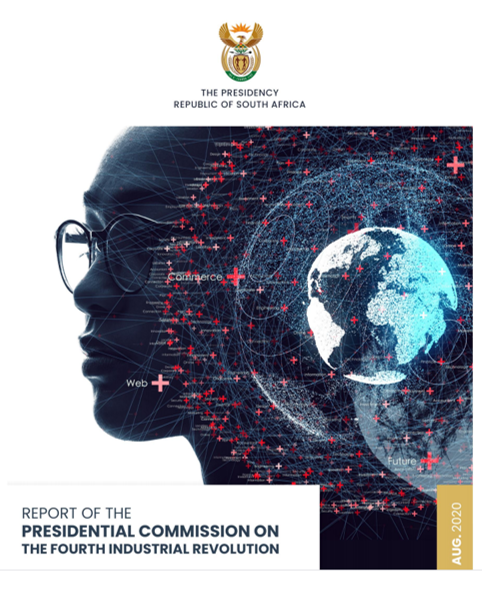Research Report: Assessing South Africa Readiness for the Fourth Industrial Revolution

A synopsis of a study on South Africa's readiness for the Fourth Industrial Revolution
Oluseye Jegede, PhD

The first industrial revolution started in the 19th century with mechanical production powered by water and steam from history. In contrast, the second industrial revolution began in the early 20th century, which resulted in mass production powered by electricity. The third industrial revolution was known to have taken off in the 1970s, which resulted in electronics and automized production. Physical systems characterized the first and second industrial revolutions. In contrast, the third industrial revolution was characterized by cyber systems, i.e., premised on virtual systems (less physical). The fourth industrial revolution, which just started, is characterized by combining physical and cyber systems, making it unique. The fourth industrial revolution allows humans and machines to work together in such a creative way that the outcome will surpass the output of humans working alone or machines working alone as has been in the previous industrial revolutions. Artificial Intelligence brands this fourth industrial revolution, Robotics and Autonomous Systems, Modelling and Simulation, Additive Manufacturing, Augmented and Virtual Reality, Data Analytics, amongst others.
Review of South Africa’s STI Landscape for the Fourth Industrial Revolution
According to the 2019 White paper for Science and Technology, South Africa’s government strengthens the country's research system by strengthening existing institutions responsible for knowledge production and creating new ones where necessary. Through the National Research Foundation, South Africa has provided grants, bursaries, and incentives to university staff and students. Also, the South African Research Chair Initiative has been expanded as more chairs have been award to researchers (particularly females) over the last few years. Also, more Centres of Excellence for specified research have increased significantly in response to South Africa's STI policy. The 2016 Global Innovation Index also recognized that South Africa is strong in market sophistication, innovation investment, knowledge absorption, and knowledge impact. However, patenting remains an area yet to be developed. South Africa remains a net importer of technology. Reports from the Department of Science and Innovation indicate that South Africa's STI expenditure has increased nine-fold. But despite these investments, South Africa's research intensity (Gross Expenditure on Research and Development as a percentage of GDP) stagnates at 0.7% over the years.
Review of the South African NSI for the fourth industrial revolution
Compared to other African countries, the South African National System of Innovation (NSI) may be judged as relatively advanced. However, there are still systemic weaknesses in the framework. The pre-NSI policy and institutional environment were driven by objectives such as military dominance (in a regional context), food security (in terms of national security), and energy self-sufficiency.
The intervention provided by the 2019 White Paper process covered six themes: "(i) Promoting competitiveness and job creation, (ii) Enhancing the quality of life, (iii) Developing human resources, (iv) Working towards environmental sustainability, (v) Promoting an information society, (vi) Producing more knowledge-embedded products and services”.
Consequently, South Africa’s NSI insufficiently supported a transition from a firm reliance on a resource-and commodity-based economy to one that would be characterized by value-adding and knowledge-intensive activities. South Africa’s NSI had some fundamental challenges. There seemed to be only limited horizontal coherence and integration between actors and stakeholders in the NSI. There was no coordinating body at the national level to devise and monitor national-level strategies for innovation and marshaling the resources needed. The National Council on Innovation (NACI), the body that should be coordinating the NSI, was hamstrung because it reported to the then Department of Science and Technology and not the presidency. And thus, NACI had no structural location that would afford it the authority needed to coordinate a national system effectively.
Another main challenge was that the business sector did not adequately participate in building the NSI. At the same time, the business sector accounts for more than half of the research intensity in South Africa. The business sector needs to be more strategic in the way they fund research. They only make funds available for researchers and students. Research funding needs to be problem-based (demand-driven), not to increase the overall amount of knowledge produced in the country's supply (supply-driven).
Evaluations of South African STI Policy for the Fourth Industrial Revolution
Within this shifting global environment, the 2019 White Paper places innovation at the forefront of helping South Africa address its socioeconomic challenges successfully adapt to the changing global landscape. It noted that the extent of South Africa's success in achieving these developmental goals would depend on the active collaboration between the private, public, academia, and civil society. The 2019 White Paper, therefore, emphasizes a quadruple helix approach and recognizes that the innovation outcome of the country would depend on strengthening the networks and relationships between institutions.
Evidence-based policymaking is at the forefront of the 2019 white paper on STI. Evidenced-based policymaking would require setting up a completely new STI government agenda, the increased collaboration of all STI partners, and the increased participation of all stakeholders to facilitate the learning and implementation of policy and specific STI initiatives.
Is South Africa’s Government Ready for the Fourth Industrial Revolution?
Based on the policy documents and other government documents reviewed, it is evident that South Africa still operates mainly with the ‘linear model of innovation’ that focuses on increasing investment research and development and creating strong science and technology organizations/institutions. The broader view of the innovation system emphasizes the linkages and interactions within the system. While South Africa has some very strong institutions, the interactions among the actors and stakeholders within the innovation system are still somewhat weak. Scholars have stressed the importance of collaboration among government, business, industry, research institutions, science councils and universities, and the public. Hence, the government has an essential role in creating an enabling environment for knowledge development and innovation through the interaction of the actors within the innovation system. Government should make the right external framework conditions necessary for creation. These external conditions include macro-economic stability, social context, political milieu standards, funding, among others. Apart from this, through policies and suitable instruments, the government must ensure the supply and mobility of knowledge workers: human resource development, immigration law, networking mechanisms.
Furthermore, the government needs to encourage the promotion of knowledge exchange/flows within the innovation system. Another essential role of government will be to ensure the timely provision of knowledge infrastructure (public research organizations, provision of scientific and technological services, provision of research and communication infrastructure). In addition to those mentioned above, the government will need to ensure that timely monitoring and evaluation are done as the government provides that its policies are based on evidence.
Universities have played a crucial role in knowledge generation. Still, in South Africa, the outputs are more supply-driven rather than demand-driven. Hence, the vast amount of research/knowledge/technology produced over the years has not sufficiently harmonized with the necessities of the NSI. Another main challenge is that South African technology abroad receipts are deficient compared with those of developed countries. Therefore, there is a considerable gap between payments for technology from abroad and receipts.
The Business sector also has a vital role in preparing the innovation for the fourth industrial revolution in South Africa. However, South Africa's GERD/GDP ratio hovers around 0.7 to 0.8%. The business sector (including state-owned entities) accounts for at least half of this South Africa’s research intensity. Hence, the kind of research done or being funded by the business sector plays a vital role in the overall development of South Africa.
Thus, the study concludes that while strong institutions characterize South Africa's research and innovation system, the relatively low intensity of linkages and interaction among the key actors of the innovation system continues to pose a threat to South Africa taking a leadership position to significantly contribute to the fourth industrial revolution. The implementation of policies must follow the broad view of innovation system, which encourages collective production of knowledge, technology, and innovation by all the actors/elements/stakeholders of the innovation system—as against focusing on building strong research and development institutions with specific mandates, working in isolation. The study puts forward that strong coordination among South Africa's financial, human, natural, physical, and institutional resources will help South Africa build capacity to leapfrog, to be a global contributor to the fourth industrial revolution.